engine MERCEDES-BENZ METRIS 2020 MY20 Operator’s Manual
[x] Cancel search | Manufacturer: MERCEDES-BENZ, Model Year: 2020, Model line: METRIS, Model: MERCEDES-BENZ METRIS 2020Pages: 320, PDF Size: 26.38 MB
Page 21 of 320
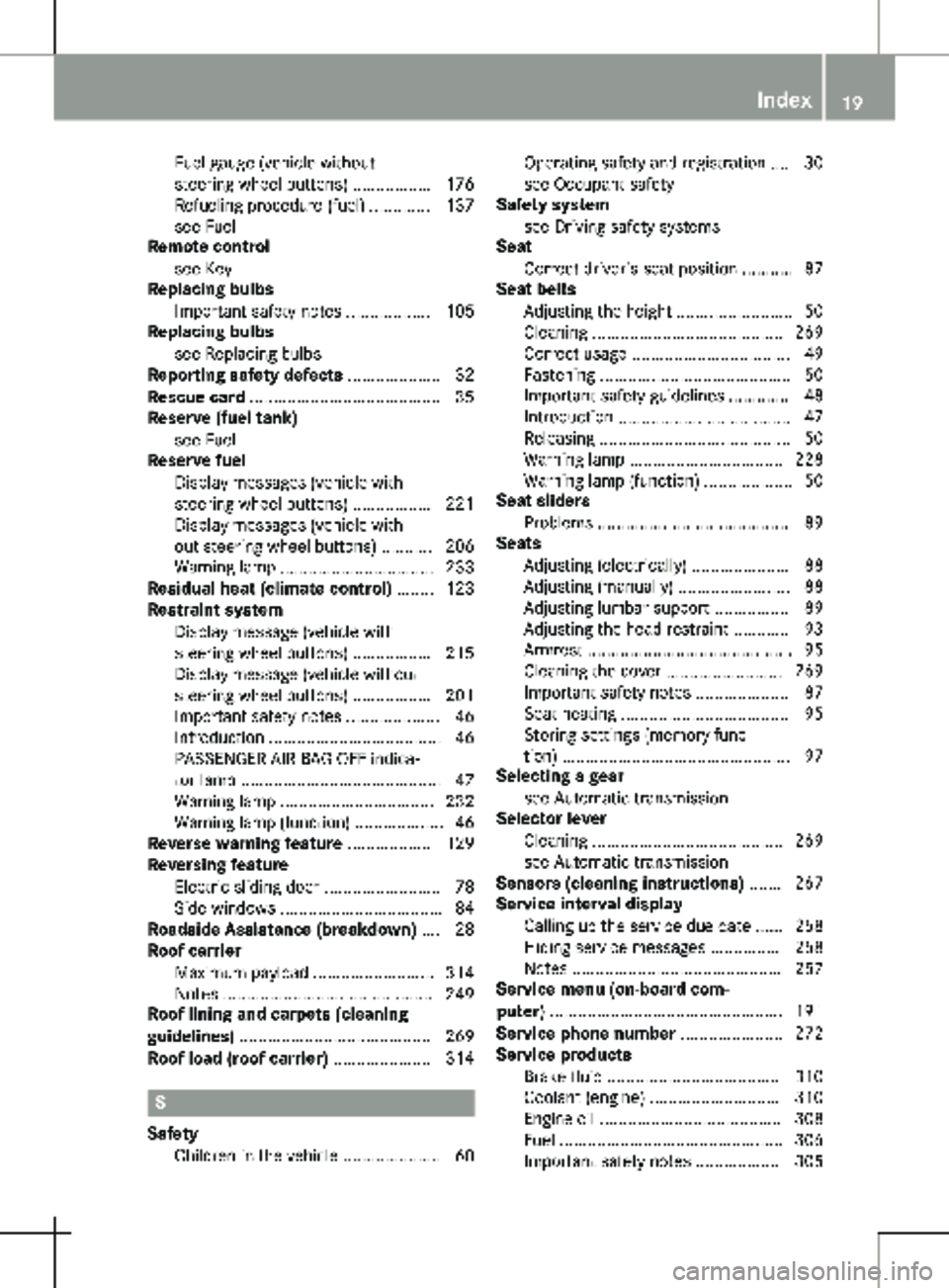
Fuel gauge (vehicle without
steering wheel buttons) .................
176
Refueling procedure (fuel) ............. 137
see Fuel
Remote control
see Key
Replacing bulbs
Important safety notes .................. 105
Replacing bulbs
see Replacing bulbs
Reporting safety defects .................... 32
Rescue card ......................................... 35
Reserve (fuel tank) see Fuel
Reserve fuel
Display messages (vehicle with
steering wheel buttons) ................. 221
Display messages (vehicle with-
out steering wheel buttons) ........... 206
Warning lamp ................................. 233
Residual heat (climate control) ........ 123
Restraint system
Display message (vehicle with
steering wheel buttons) ................. 215
Display message (vehicle without
steering wheel buttons) ................. 201
Important safety notes .................... 46
Introduction ..................................... 46
PASSENGER AIR BAG OFF indica-
tor lamp ........................................... 47
Warning lamp ................................. 232
Warning lamp (function) ................... 46
Reverse warning feature .................. 129
Reversing feature
Electric sliding door ......................... 78
Side windows ................................... 84
Roadside Assistance (breakdown) .... 28
Roof carrier
Maximum payload .......................... 314
Notes ............................................. 249
Roof lining and carpets (cleaning
guidelines) ......................................... 269
Roof load (roof carrier) ..................... 314S
Safety Children in the vehicle
..................... 60 Operating safety and registration .... 30
see Occupant safety
Safety system
see Driving safety systems
Seat
Correct driver's seat position ...........
87
Seat belts
Adjusting the height ......................... 50
Cleaning ......................................... 269
Correct usage .................................. 49
Fastening ......................................... 50
Important safety guidelines ............. 48
Introduction ..................................... 47
Releasing ......................................... 50
Warning lamp ................................. 228
Warning lamp (function) ................... 50
Seat sliders
Problems ......................................... 89
Seats
Adjusting (electrically) ..................... 88
Adjusting (manually) ........................ 88
Adjusting lumbar support ................ 89
Adjusting the head restraint ............ 93
Armrest ............................................ 95
Cleaning the cover ......................... 269
Important safety notes .................... 87
Seat heating .................................... 95
Storing settings (memory func-
tion) ................................................. 97
Selecting a gear
see Automatic transmission
Selector lever
Cleaning ......................................... 269
see Automatic transmission
Sensors (cleaning instructions) ....... 267
Service interval display
Calling up the service due date ...... 258
Hiding service messages ............... 258
Notes ............................................. 257
Service menu (on-board com-
puter) .................................................. 191
Service phone number ...................... 272
Service products
Brake fluid ..................................... 310
Coolant (engine) ............................ 310
Engine oil ....................................... 308
Fuel ................................................ 306
Important safety notes .................. 305 Index
19
Page 23 of 320

Starting
see Starting (engine)
Starting (engine) ................................
128
Status overview (on-board com-
puter) .................................................. 189
Steering
Display messages (vehicle with
steering wheel buttons) ................. 227
Display messages (vehicle with-
out steering wheel buttons) ........... 208
Warning lamps ............................... 237
Steering wheel
Adjusting ......................................... 95
Button overview ............................... 42
Buttons (on-board computer) ......... 181
Cleaning ......................................... 269
Paddle shifters ............................... 135
Steering wheel paddle shifters ........ 135
Stickers
General safety notes ........................ 29
Stowage net ....................................... 239
Stowage spaces
see Stowage spaces and stow-
age compartments
Stowage spaces and stowage
compartments
Eyeglasses compartment ............... 238
Glove box ....................................... 238
Important safety notes .................. 238
Stowage net ................................... 239
Summer opening
see Convenience opening feature
Summer tires
In winter ........................................ 280
Sun visor
Changing a bulb (mirror lamp) ....... 104
Overview ........................................ 239
Surround lighting (on-board com-
puter) .................................................. 193
Switching air-recirculation mode
on/off ................................................. 123
Switching off the alarm (ATA) ............ 70T
Tachometer ........................................
175Tail lamps
Display messages (vehicle with-
out steering wheel buttons)
........... 202
Replacing bulbs ............................. 108
Trailer display messages (vehicle
with steering wheel buttons) .. 216, 217
Trailer display messages (vehicle
without steering wheel buttons) .... 202
Tailgate
Changing bulbs (ambient lamp) ..... 104
Display messages (vehicle with
steering wheel buttons) ................. 226
Display messages (vehicle with-
out steering wheel buttons) ........... 208
Important safety notes .................... 81
Opening dimensions ...................... 313
Opening/closing from the out-
side .................................................. 81
Replacing light bulbs (signal/
ambient lamp) ................................ 105
Tank
see Fuel tank
Tank contents
Displaying the range (vehicle
with steering wheel buttons) ......... 184
Displaying the range (vehicle
without steering wheel buttons) .... 178
Technical data
Capacities ...................................... 305
Cargo tie-down points .................... 313
Guide rail ....................................... 314
Loading rails .................................. 314
Roof carrier .................................... 314
Tires/wheels ................................. 301
Trailer tow hitch ............................. 315
Vehicle data ................................... 312
Vehicle dimensions ........................ 313
Telephone
Accepting a call ............................. 188
Display message ............................ 227
Introduction ................................... 188
Number from the phone book ........ 188
Redialing ........................................ 189
Rejecting/ending a call ................. 188
Temperature
Coolant (display in the instru-
ment cluster) ................................. 175 Index
21
Page 25 of 320
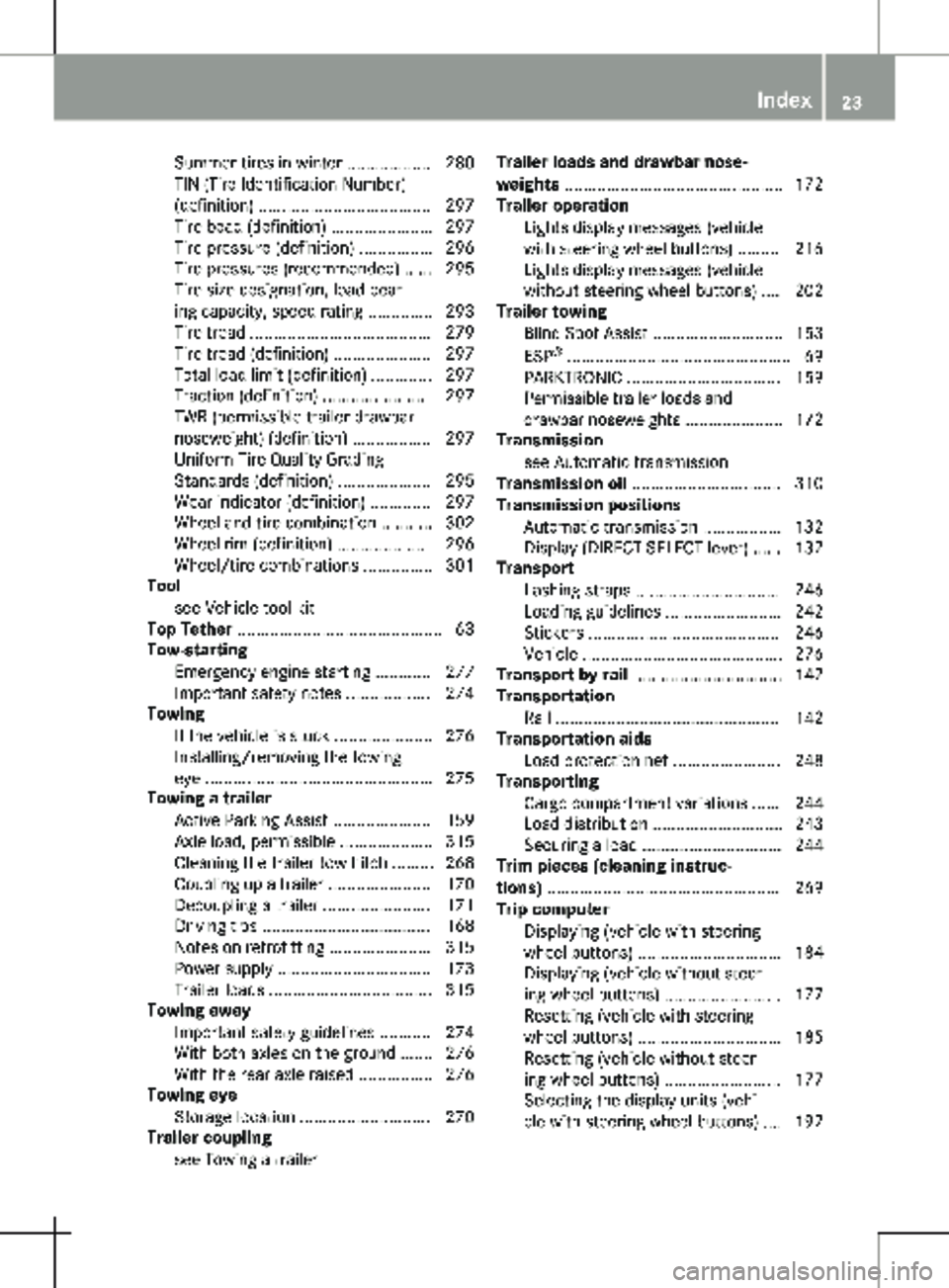
Summer tires in winter .................. 280
TIN (Tire Identification Number)
(definition) .....................................
297
Tire bead (definition) ...................... 297
Tire pressure (definition) ................ 296
Tire pressures (recommended) ...... 295
Tire size designation, load-bear-
ing capacity, speed rating .............. 293
Tire tread ....................................... 279
Tire tread (definition) ..................... 297
Total load limit (definition) ............. 297
Traction (definition) ....................... 297
TWR (permissible trailer drawbar
noseweight) (definition) ................. 297
Uniform Tire Quality Grading
Standards (definition) .................... 295
Wear indicator (definition) ............. 297
Wheel and tire combination ........... 302
Wheel rim (definition) .................... 296
Wheel/tire combinations ............... 301
Tool
see Vehicle tool kit
Top Tether ............................................ 63
Tow-starting
Emergency engine starting ............ 277
Important safety notes .................. 274
Towing
If the vehicle is stuck ..................... 276
Installing/removing the towing
eye ................................................. 275
Towing a trailer
Active Parking Assist ..................... 159
Axle load, permissible .................... 315
Cleaning the trailer tow hitch ......... 268
Coupling up a trailer ...................... 170
Decoupling a trailer ....................... 171
Driving tips .................................... 168
Notes on retrofitting ...................... 315
Power supply ................................. 173
Trailer loads ................................... 315
Towing away
Important safety guidelines ........... 274
With both axles on the ground ....... 276
With the rear axle raised ................ 276
Towing eye
Storage location ............................ 270
Trailer coupling
see Towing a trailer Trailer loads and drawbar nose-
weights
...............................................
172
Trailer operation
Lights display messages (vehicle
with steering wheel buttons) ......... 216
Lights display messages (vehicle
without steering wheel buttons) .... 202
Trailer towing
Blind Spot Assist ............................ 153
ESP ®
................................................ 69
PARKTRONIC ................................. 159
Permissible trailer loads and
drawbar noseweights ..................... 172
Transmission
see Automatic transmission
Transmission oil ................................ 310
Transmission positions
Automatic transmission ................. 132
Display (DIRECT SELECT lever) ...... 132
Transport
Lashing straps ............................... 246
Loading guidelines ......................... 242
Stickers ......................................... 246
Vehicle ........................................... 276
Transport by rail ................................ 142
Transportation
Rail ................................................ 142
Transportation aids
Load protection net ....................... 248
Transporting
Cargo compartment variations ...... 244
Load distribution ............................ 243
Securing a load .............................. 244
Trim pieces (cleaning instruc-
tions) .................................................. 269
Trip computer
Displaying (vehicle with steering
wheel buttons) ............................... 184
Displaying (vehicle without steer-
ing wheel buttons) ......................... 177
Resetting (vehicle with steering
wheel buttons) ............................... 185
Resetting (vehicle without steer-
ing wheel buttons) ......................... 177
Selecting the display units (vehi-
cle with steering wheel buttons) .... 192 Index
23
Page 27 of 320

Vehicle data .......................................
312
Vehicle dimensions ........................... 313
Vehicle emergency locking ................ 73
Vehicle identification number
see VIN
Vehicle identification plate .............. 304
Vehicle key
see SmartKey
Vehicle tool kit
in the seat base ............................. 270
Scope ............................................ 270
Storage location ............................ 270
Stowage compartment in the
rear ................................................ 271
Stowage space in the cargo com-
partment ........................................ 272
Ventilation
see Climate control
Vents
see Air vents
VIN
Engine compartment ..................... 305
Type plate ...................................... 304 W
Warning Stickers
........................................... 29
Warning and indicator lamps
ABS ................................................ 230
Brakes ........................................... 229
Check Engine ................................. 233
COLLISION PREVENTION ASSIST .. 235
Coolant .......................................... 233
Distance warning ........................... 235
Door ............................................... 237
ESP ®
.............................................. 230
ESP ®
OFF ....................................... 232
Fuel tank ........................................ 233
General notes ................................ 227
Overview (vehicle with steering
wheel buttons) ................................. 41
Overview (vehicle without steer-
ing wheel buttons) ........................... 39
Parking brake ................................ 138
PASSENGER AIR BAG OFF ............... 47
Rear door ....................................... 237
Reserve fuel ................................... 233 Restraint system ............................ 232
Seat belt ........................................
228
Sliding door ................................... 237
Steering ......................................... 237
Tire pressure monitor .................... 236
Warranty .............................................. 27
Washer fluid
Adding ........................................... 256
Capacities ...................................... 312
Display messages (vehicle with
steering wheel buttons) ................. 227
Display messages (vehicle with-
out steering wheel buttons) ........... 209
Notes ............................................. 312
Wheel and tire combination
see Tires
Wheel bolt tightening torque ........... 300
Wheels
Changing a wheel .......................... 297
Checking ........................................ 279
Cleaning ......................................... 266
Important safety notes .................. 278
Interchanging/changing ................ 297
Mounting a new wheel ................... 300
Mounting a wheel .......................... 298
Removing a wheel .......................... 299
Removing and mounting the
spare wheel ................................... 303
Snow chains .................................. 281
Storing ........................................... 298
Tightening torque ........................... 300
Wheel/tire combinations ............... 301
Window curtain air bag
Display message (vehicle with
steering wheel buttons) ................. 215
Display message (vehicle without
steering wheel buttons) ................. 201
Operation ......................................... 53
Windows
see Side windows
Windows misted up
see Climate control
Windshield
Cleaning ......................................... 265
Defrosting ...................................... 121
Windshield
see Windshield Index
25
Page 30 of 320

Mercedes-Benz, LLC has been informed in
writing of the necessity of such a repair.
(2) the same defect or damage, although less serious than described in (1), has been
repaired at least four times and Mercedes-
Benz has been informed of the necessity
of such a repair in writing.
(3) the vehicle cannot be operated for more than 30 calendar days due to repairs
resulting from the same or other major
defects or damage.
Please send written notification to:
Mercedes-Benz USA, LLC
Customer Assistance Center
One Mercedes-Benz
Sandy Springs, GA 30328 Maintenance
USA only:
Always bring the Maintenance Booklet with
you when taking the vehicle to a Mercedes-
Benz Commercial Van Center. Your customer
service advisor enters each service into the
Maintenance Booklet.
Canada only:
Have every service carried out by a qualified
specialist workshop recorded in your service
report. Roadside Assistance
The Mercedes-Benz Roadside Assistance Pro-
gram provides you with technical assistance in
the case of a breakdown. Your toll-free calls to
the Roadside Assistance Hotline are answered
by our staff around the clock. 365 days a year.
1-800-FOR-MERCedes
(1-800-367-6372)
(USA)
1-800-387-0100 (Canada)
Further information can be found in the
Mercedes-Benz Roadside Assistance-Program
brochure (USA) or the "Roadside Assistance"
section of the Service and Warranty Informa-
tion booklet (Canada). Both are located in your
vehicle document wallet. Change of address or owner
Please use the "Notice of Change of Address"
form in the Service and Warranty Information
booklet to inform us of a change of address, or
simply phone the Mercedes-Benz Customer
Assistance Center (USA) on hotline number
1-800-FOR-MERCedes
(1-800-367-6372) or
Customer Service (Canada) on
1-800-387-0100. This enables us, if neces-
sary, to contact you at any time.
If you sell your Mercedes, please leave all the
literature in the vehicle so that it is available
for the next owner.
If your vehicle was purchased as a used vehi-
cle, please send us the "Notice of Purchase of
Used Car" from the Service and Warranty
Information booklet or phone the Mercedes-
Benz Customer Assistance Center (USA) on
hotline number 1-800-FOR-MERCedes
(1-800-367-6372) or Customer Service (Can-
ada) on 1-800-387-0100. Operating the vehicle outside of the
USA and Canada
When traveling abroad with your vehicle,
observe the following points: R Service facilities or replacement parts may
not be available immediately.
R Unleaded fuel for vehicles with a catalytic
converter may not be available. Leaded fuel
can cause damage to the catalytic con-
verter.
R The fuel may have a considerably lower
octane rating. Unsuitable fuel can cause
engine damage.
Certain Mercedes-Benz models are available in
Europe through our European Delivery Pro-
gram. Please consult a Mercedes-Benz Com-
mercial Van Center for further information, or
write to one of the following addresses:
In the USA
Mercedes-Benz USA, LLC
European Delivery Department
One Mercedes Drive
Montvale, NJ 07645-0350
In Canada
Mercedes-Benz Canada, Inc.
European Delivery Department
98 Vanderhoof Avenue 28
Introduction
Page 32 of 320
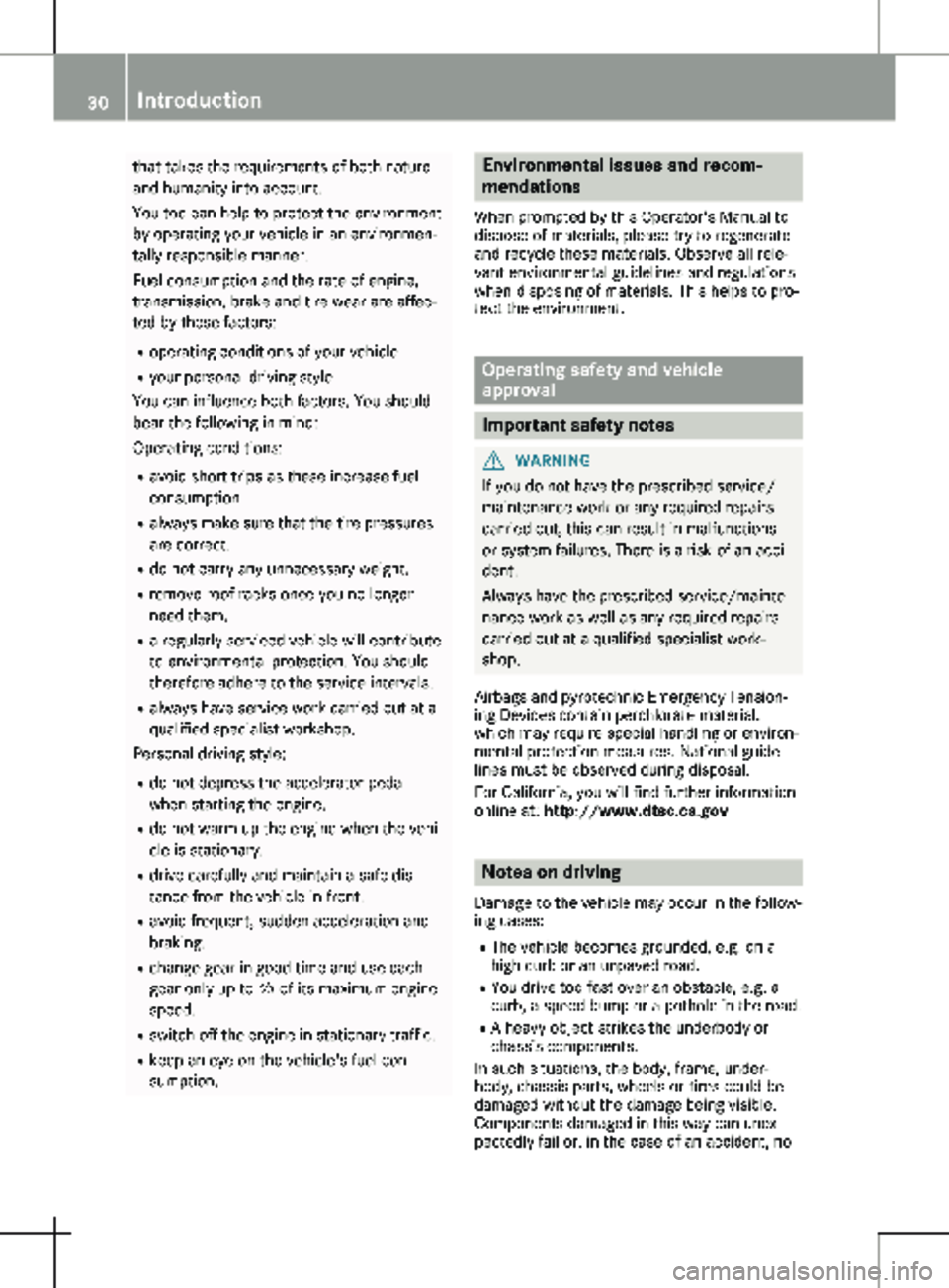
that takes the requirements of both nature
and humanity into account.
You too can help to protect the environment
by operating your vehicle in an environmen-
tally responsible manner.
Fuel consumption and the rate of engine,
transmission, brake and tire wear are affec-
ted by these factors:
R operating conditions of your vehicle
R your personal driving style
You can influence both factors. You should
bear the following in mind:
Operating conditions:
R avoid short trips as these increase fuel
consumption.
R always make sure that the tire pressures
are correct.
R do not carry any unnecessary weight.
R remove roof racks once you no longer
need them.
R a regularly serviced vehicle will contribute
to environmental protection. You should
therefore adhere to the service intervals.
R always have service work carried out at a
qualified specialist workshop.
Personal driving style:
R do not depress the accelerator pedal
when starting the engine.
R do not warm up the engine when the vehi-
cle is stationary.
R drive carefully and maintain a safe dis-
tance from the vehicle in front.
R avoid frequent, sudden acceleration and
braking.
R change gear in good time and use each
gear only up to Ô of its maximum engine
speed.
R switch off the engine in stationary traffic.
R keep an eye on the vehicle's fuel con-
sumption. Environmental issues and recom-
mendations
When prompted by this Operator's Manual to
dispose of materials, please try to regenerate
and recycle these materials. Observe all rele-
vant environmental guidelines and regulations
when disposing of materials. This helps to pro-
tect the environment. Operating safety and vehicle
approval
Important safety notes
G
WARNING
If you do not have the prescribed service/
maintenance work or any required repairs
carried out, this can result in malfunctions
or system failures. There is a risk of an acci-
dent.
Always have the prescribed service/mainte-
nance work as well as any required repairs
carried out at a qualified specialist work-
shop.
Airbags and pyrotechnic Emergency Tension-
ing Devices contain perchlorate material,
which may require special handling or environ-
mental protection measures. National guide-
lines must be observed during disposal.
For California, you will find further information
online at: http://www.dtsc.ca.gov Notes on driving
Damage to the vehicle may occur in the follow-
ing cases:
R The vehicle becomes grounded, e.g. on a
high curb or an unpaved road.
R You drive too fast over an obstacle, e.g. a
curb, a speed bump or a pothole in the road.
R A heavy object strikes the underbody or
chassis components.
In such situations, the body, frame, under-
body, chassis parts, wheels or tires could be
damaged without the damage being visible.
Components damaged in this way can unex-
pectedly fail or, in the case of an accident, no 30
Introduction
Page 34 of 320

Modifying the engine output
! Increases in engine power can:
R change the emission values
R cause malfunctions
R cause consequential damage
The operating reliability of the engine is not
guaranteed in all cases.
Any tampering with the engine management
system in order to increase the engine power
output will lead to the loss of the New Vehicle
Limited Warranty and other warranty entitle-
ments.
If you sell the vehicle, inform the buyer of any
alterations to the vehicle's engine power out-
put. If you do not inform the buyer, this may
constitute a punishable offense under national
legislation. Qualified specialist workshop
A Mercedes-Benz Commercial Van Center is a
qualified specialist workshop.
A qualified specialist workshop has the neces-
sary specialist knowledge, tools and qualifica-
tions to carry out the work required on the
vehicle correctly.
This is particularly applicable to work relevant
to safety. Observe the notes in the Mainte-
nance or Service Booklet.
You should always have the following work on
your vehicle carried out at a qualified special-
ist workshop:
R safety-relevant work
R service and maintenance work
R repair work
R modifications as well as installations and
conversions
R work on electronic components
Mercedes-Benz recommends that you use a
Mercedes-Benz Commercial Van Center.
! Have the engine electronics and associ-
ated parts, such as control units, sensors,
actuating components or electric cables
serviced only at a qualified specialist work-
shop. Vehicle components may otherwise
wear more quickly and the vehicle's operat-
ing permit may be invalidated. Problems with your vehicle
If you should experience a problem with your
vehicle, particularly one that you believe may
affect its safe operation, we urge you to con-
tact a Mercedes-Benz Commercial Van Center-
immediately to have the problem diagnosed
and rectified. If the problem is not resolved to
your satisfaction, please discuss the problem
again with the Mercedes-Benz Commercial
Van Center or contact us at one of the follow-
ing addresses.
In the USA:
Customer Assistance Center
Mercedes-Benz USA, LLC
One Mercedes-Benz Drive
Sandy Springs, GA 30328
In Canada:
Customer Relations Department
Mercedes-Benz Canada, Inc.
98 Vanderhoof Avenue
Toronto, Ontario M4G 4C9 Reporting malfunctions relevant to
safety
USA only:
The following text is reproduced as required of
all manufacturers under Title 49, Code of U.S.
Federal Regulations, Part 575 pursuant to the
National Traffic and Motor Vehicle Safety Act
of 1966.
If you believe that your vehicle has a defect
which could cause a crash or could cause
injury or death, you should immediately inform
the National Highway Traffic Safety Adminis-
tration (NHTSA) in addition to notifying
Mercedes-Benz USA, LLC.
If NHTSA receives similar complaints, it may
open an investigation, and if it finds that a
safety defect exists in a group of vehicles, it
may order a recall and remedy campaign.
However, NHTSA cannot become involved in
individual problems between you, your dealer,
or Mercedes-Benz USA, LLC.
To contact NHTSA, you may call the Vehicle
Safety Hotline toll-free at 1-888-327-4236
(TTY: 1-800-424-9153)
; go to http://
www.safercar.gov ; or write to: Administrator,
NHTSA, 400 Seventh Street, SW., Washington,
DC 20590. 32
Introduction
Page 35 of 320
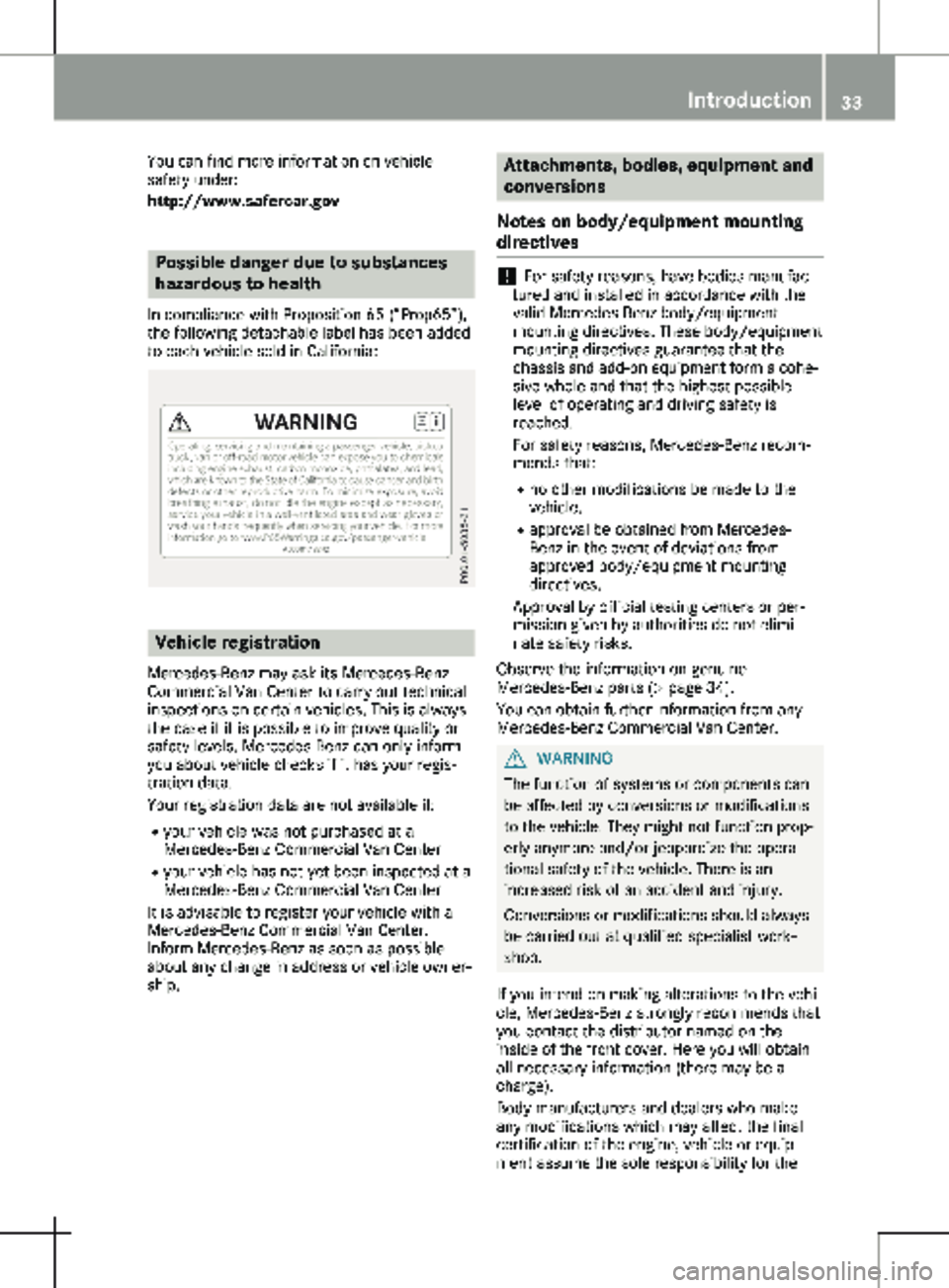
You can find more information on vehicle
safety under:
http://www.safercar.gov Possible danger due to substances
hazardous to health
In compliance with Proposition 65 (“Prop65”),
the following detachable label has been added
to each vehicle sold in California: Vehicle registration
Mercedes-Benz may ask its Mercedes-Benz
Commercial Van Center to carry out technical
inspections on certain vehicles. This is always
the case if it is possible to improve quality or
safety levels. Mercedes-Benz can only inform
you about vehicle checks if it has your regis-
tration data.
Your registration data are not available if:
R your vehicle was not purchased at a
Mercedes-Benz Commercial Van Center
R your vehicle has not yet been inspected at a
Mercedes-Benz Commercial Van Center
It is advisable to register your vehicle with a
Mercedes-Benz Commercial Van Center.
Inform Mercedes-Benz as soon as possible
about any change in address or vehicle owner-
ship. Attachments, bodies, equipment and
conversions
Notes on body/equipment mounting
directives !
For safety reasons, have bodies manufac-
tured and installed in accordance with the
valid Mercedes-Benz body/equipment
mounting directives. These body/equipment
mounting directives guarantee that the
chassis and add-on equipment form a cohe-
sive whole and that the highest possible
level of operating and driving safety is
reached.
For safety reasons, Mercedes-Benz recom-
mends that:
R no other modifications be made to the
vehicle.
R approval be obtained from Mercedes-
Benz in the event of deviations from
approved body/equipment mounting
directives.
Approval by official testing centers or per-
mission given by authorities do not elimi-
nate safety risks.
Observe the information on genuine
Mercedes-Benz parts
(Y page 34).
You can obtain further information from any
Mercedes-Benz Commercial Van Center. G
WARNING
The function of systems or components can
be affected by conversions or modifications
to the vehicle. They might not function prop-
erly anymore and/or jeopardize the opera-
tional safety of the vehicle. There is an
increased risk of an accident and injury.
Conversions or modifications should always
be carried out at qualified specialist work-
shop.
If you intend on making alterations to the vehi-
cle, Mercedes-Benz strongly recommends that
you contact the distributor named on the
inside of the front cover. Here you will obtain
all necessary information (there may be a
charge).
Body manufacturers and dealers who make
any modifications which may affect the final
certification of the engine, vehicle or equip-
ment assume the sole responsibility for the Introduction
33 Z
Page 36 of 320

vehicle. This also includes labeling and docu-
mentation affected by their modifications.
It is their responsibility to certify that:
R the altered vehicle conforms to all applica-
ble standards and regulations affected by
the vehicle alteration
R the altered vehicle continues to comply with
the motor vehicle safety standards and
emissions regulations
R the changes or installation of accessories do
not impair the safety of the vehicle
We are not responsible for any final certifica-
tion or claims regarding product liability or
warranty claims that arise as a result of such
changes. This applies to:
R components, assemblies or systems which
have been altered
R non-compliance with emissions laws and
regulations or with vehicle safety standards
arising as a result of the alterations
R all consequences resulting form the
changed, less safe or even defective vehicle
We do not assume responsibility as the final
stage manufacturer or the consequential prod-
uct liability.
Notes on the engine radiator Even seemingly small changes to the vehicle,
such as attaching a radiator trim for winter
driving or as protection against insects, are
not permitted. Do not cover the radiator. Do
not use thermal mats, insect protection covers
or anything similar.
Doing so can cause the diagnostics system to
display inaccurate values. Some of these val-
ues are legally required and must always be
correct.
Notes for commercial vehicles without
partitions Vehicles, which are approved as commercial
vehicles (N1), do not comply with the
ISO 27956
standard in the respective current
valid version unless equipped with a partition.
The ISO 27956 Standard details the equip-
ment for correct load securing in delivery vehi-
cles. Retrofitting the partition is strongly rec-
ommended when using the vehicle for the
transport of goods, as correct load securing in
vehicles without the partition is difficult to
achieve. Genuine Mercedes-Benz parts
! Air bags and Emergency Tensioning Devi-
ces, as well as control units and sensors for
these restraint systems, may be installed in
the following areas of your vehicle:
R doors
R door pillars
R door sills
R seats
R cockpit
R instrument cluster
R center console
Do not install accessories such as audio sys-
tems in these areas. Do not carry out
repairs or welding. You could impair the
operating efficiency of the restraint sys-
tems.
Have aftermarket accessories installed at a
qualified specialist workshop. H
Environmental note
We supply reconditioned assemblies and
parts which are of the same quality as new
parts. The same New Vehicle Limited War-
ranty applies as for new parts.
The operating safety of the vehicle could be
jeopardized if you use parts, tires and wheels
as well as accessories relevant to safety which
have not been approved by Mercedes-Benz.
This could lead to malfunctions in safety-rele-
vant systems, e.g. the brake system. Only use
genuine Mercedes-Benz parts or parts of equal
quality. Only use tires, wheels and accessories
that have been specifically approved for your
vehicle.
Mercedes-Benz tests genuine Mercedes-Benz
parts, conversion parts and accessories that
have been specifically approved for the type of
vehicle for:
R Reliability
R Safety
R Suitability
Despite ongoing market research, Mercedes-
Benz is unable to assess other parts. Even if
an independent or official approval has been
provided in exceptional cases, Mercedes-Benz
accepts no responsibility for the use of such
parts in Mercedes-Benz vehicles. 34
Introduction
Page 37 of 320
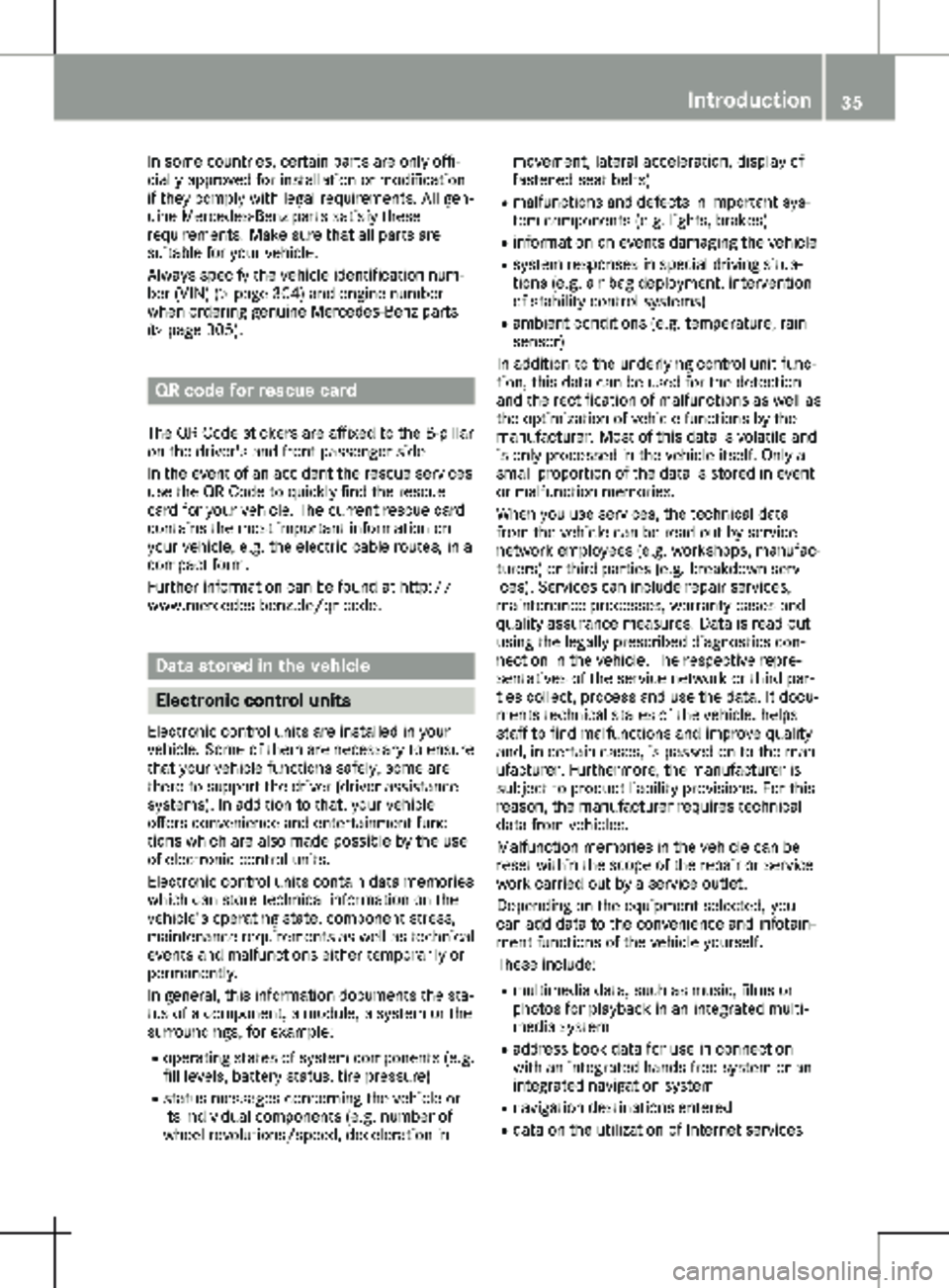
In some countries, certain parts are only offi-
cially approved for installation or modification
if they comply with legal requirements. All gen-
uine Mercedes-Benz parts satisfy these
requirements. Make sure that all parts are
suitable for your vehicle.
Always specify the vehicle identification num-
ber (VIN) ( Y page
304) and engine number
when ordering genuine Mercedes-Benz parts
(Y page 305). QR code for rescue card
The QR Code stickers are affixed to the B-pillar
on the driver's and front-passenger side.
In the event of an accident the rescue services
use the QR Code to quickly find the rescue
card for your vehicle. The current rescue card
contains the most important information on
your vehicle, e.g. the electric cable routes, in a
compact form.
Further information can be found at http://
www.mercedes-benz.de/qr-code. Data stored in the vehicle
Electronic control units
Electronic control units are installed in your
vehicle. Some of them are necessary to ensure
that your vehicle functions safely, some are
there to support the driver (driver assistance
systems). In addition to that, your vehicle
offers convenience and entertainment func-
tions which are also made possible by the use
of electronic control units.
Electronic control units contain data memories
which can store technical information on the
vehicle's operating state, component stress,
maintenance requirements as well as technical
events and malfunctions either temporarily or
permanently.
In general, this information documents the sta-
tus of a component, a module, a system or the
surroundings, for example:
R operating states of system components (e.g.
fill levels, battery status, tire pressure)
R status messages concerning the vehicle or
its individual components (e.g. number of
wheel revolutions/speed, deceleration in movement, lateral acceleration, display of
fastened seat belts)
R malfunctions and defects in important sys-
tem components (e.g. lights, brakes)
R information on events damaging the vehicle
R system responses in special driving situa-
tions (e.g. air bag deployment, intervention
of stability control systems)
R ambient conditions (e.g. temperature, rain
sensor)
In addition to the underlying control unit func-
tion, this data can be used for the detection
and the rectification of malfunctions as well as
the optimization of vehicle functions by the
manufacturer. Most of this data is volatile and
is only processed in the vehicle itself. Only a
small proportion of the data is stored in event
or malfunction memories.
When you use services, the technical data
from the vehicle can be read out by service
network employees (e.g. workshops, manufac-
turers) or third parties (e.g. breakdown serv-
ices). Services can include repair services,
maintenance processes, warranty cases and
quality assurance measures. Data is read out
using the legally prescribed diagnostics con-
nection in the vehicle. The respective repre-
sentatives of the service network or third par-
ties collect, process and use the data. It docu-
ments technical states of the vehicle, helps
staff to find malfunctions and improve quality
and, in certain cases, is passed on to the man-
ufacturer. Furthermore, the manufacturer is
subject to product liability provisions. For this
reason, the manufacturer requires technical
data from vehicles.
Malfunction memories in the vehicle can be
reset within the scope of the repair or service
work carried out by a service outlet.
Depending on the equipment selected, you
can add data to the convenience and infotain-
ment functions of the vehicle yourself.
These include:
R multimedia data, such as music, films or
photos for playback in an integrated multi-
media system
R address book data for use in connection
with an integrated hands-free system or an
integrated navigation system
R navigation destinations entered
R data on the utilization of Internet services Introduction
35 Z